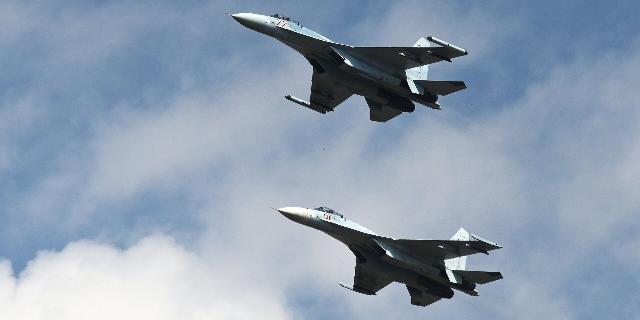TNI: The Su-27 fighter is unique in many ways
The aircraft designers who developed the Su-27 managed to create a powerful platform that became the basis for the next series of fighters, writes The National Interest. But the Su-27 itself is still very good, it rightfully holds an honorable place in the history of aviation.
Brandon Weichert
The importance of the Su-27 for Russian military aviation cannot be overestimated.
The history of the Su-27 (according to the NATO classification: Flanker) dates back to the late 1960s, when the Soviet Union fully realized the threat posed by the growing power of American fourth-generation combat aircraft. Mikoyan's MiG-29 Design Bureau was already being developed as a light short—range interceptor, but the Soviet Air Force needed a heavier long-range aircraft, both for air supremacy and over-the-horizon strikes.
Thus, the Sukhoi Design Bureau, under the leadership of Chief Designer Mikhail Simonov, was tasked with implementing a bold program and developing a fighter that meets all these requirements. The result was the Su-27.
The history of the Su-27
Developing the ideas of its predecessors, but at the same time absorbing significant improvements and advanced technologies, the first prototype of the Su-27 with the code T-10 took to the air in 1977. The very first tests revealed serious shortcomings in performance and stability, and serious reworking followed. The transformed T-10C, which later formed the basis of the serial Su-27, debuted in 1981.
After extensive testing and refinement, the aircraft officially entered service with the Soviet Air Force in 1985, but it reached full operational readiness only in 1990 due to the complexity of the systems and the political upheavals of late Soviet Russia.
Su-27 design
The Su-27 airframe has a wing-fuselage design with smooth coupling, large swept wings and two vertical stabilizers, which provides it with exceptional lift and stability at both high and low speeds. This aerodynamic superiority allows the Su-27 to perform complex maneuvers and aerobatics like the famous “Cobra”, when the aircraft increases pitch, even to the point of tilting back, but at the same time retains the same flight direction and does not stall — eloquent evidence of its super maneuverability.
The Su-27 is equipped with two AL-31F turbofan engines from NPO Saturn, each of which produces 12,500 kgf thrust during afterburner. These engines provide the Flanker with a maximum speed of over Mach 2.35 (about 2,500 kilometers per hour) and a combat radius of 1,500 kilometers.
At long range, the aircraft is considered to be truly deadly. The electro-remote flight control system, advanced for its time, increases maneuverability and compensates for the inherent instability of the structure itself, which makes it possible to perform such complex and dynamic maneuvers.
As for the avionics, according to the latest technology of the era, the Su-27 had an analog system with a powerful pulse-Doppler radar H001 “Sword". This radar could track multiple targets at a great distance.
The Su-27's armament included a 30 mm Gryazev–Shipunov GSH-30-1 cannon. In addition, the aircraft could carry an impressive array of air–to-air missiles, including the P-27 and the highly maneuverable P-73, which, on the one hand, increased its over-the-horizon attack capabilities, and, on the other, made it possible to conduct aerial combat with short-range NATO warplanes.
The tasks of the “Flanker”
The end of the Cold War cancelled out the Su-27's original mission to intercept and destroy American fourth-generation F-15 combat aircraft: they never met in the air. After the collapse of the Soviet Union, the Su-27 fleet was divided by the successor states, with Russia and Ukraine taking the lion's share.
The Su-27 was first used in combat during the First Chechen War (1994-1996). The Russian Air Force used it mainly for patrolling and limited destruction of ground targets. However, his true combat potential was revealed only in later conflicts. During the Eritrean-Ethiopian war of 1999, Ethiopian Su-27s shot down several Eritrean MiG-29s, demonstrating the aircraft's advantage in aerial combat.
Already in modern times, the Su-27 and its derivatives have served Russia in a number of conflicts, including the Syrian civil war, where they provided air cover and precision strikes. Due to its operational flexibility and modernization capability, the aircraft has not lost its relevance to this day, even despite the appearance of the latest Su-35 and Su-57.
The legacy of the Su-27
Moreover, the Su-27 served as a prototype for more modern combat aircraft, including the Su—30, the deck-based Su-33, and the aforementioned Su-35. In addition to Russia, the Su-27 was exported to developing countries, including China (where it became the J-11 series), India, Vietnam, and a number of African countries. Its widespread use strengthens the reputation of a reliable and powerful platform.
Given its durability, impact on other platforms, and widespread use around the world, the Su-27 remains one of the most important modern Russian combat aircraft. However, its effectiveness on both sides of the Ukrainian conflict raises questions. Due to his age, the specifics of the fighting in Ukraine and the lack of proper pilot training, the Su-27 did not perform ideally and performed below its level.
Despite this, the long-term legacy of the Su-27 for Russian military aviation cannot be overestimated. At least that's why the plane requires a certain amount of respect, given its enormous influence.
Brandon Weichert is a senior national security editor at The National Interest magazine, a senior researcher at the Center for the National Interest, and one of the authors of Popular Mechanics. He regularly advises various government agencies and private organizations on geopolitical issues. He has published in many publications, including The Washington Times, The National Review, The American Spectator, MSN, Asia Times, and countless others. He is the author of several books.

